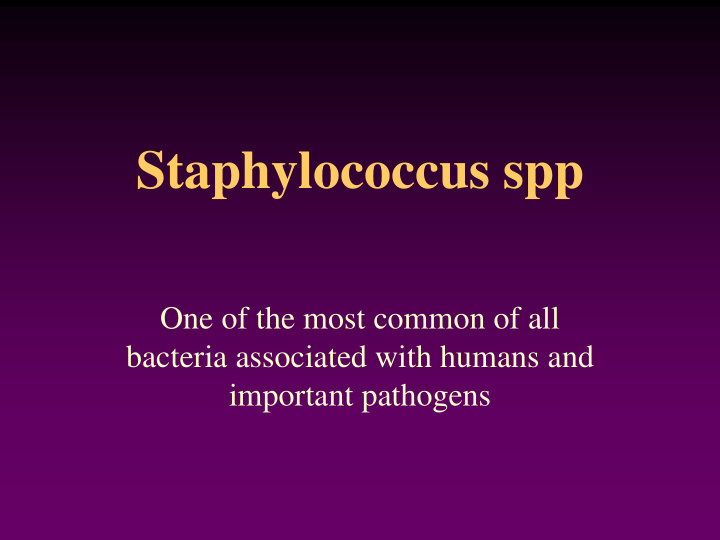



Staphylococcus spp One of the most common of all bacteria associated with humans and important pathogens
Microbiology of Staphylococcus • Gram + cocci – generally in grape-like clusters (Gr, staphyle ) • also singly, pairs, etc. • Important group !! – Normal on skin, upper respiratory tract, vagina, intestines, etc. • Three pathogenic spp – S. aureus • produces coagulase – S. epidermidis • most common organism on skin – S. saprophyticus
Microbiology continued • Pyogenic cocci – invasive “pus-formers” • Staphylococci • Streptococci • Pneumococci • numerous diseases – depending on virulence factors – major nosocomial disease agent • “staff” infections? Zones of hemolysis – hemolytic on blood due to different toxins agar • destroys RBCs, leukocytes, etc.
Virulence Factors of Staph: • Enzymes: – Staph Toxins: – Catalase – Cytotoxic toxins • interferes with • 5 cytolysins: RBC, phagocytic lysis WBC, tissue necrosis – Coagulase – Toxic Shock Syndrome • forms clots • TSST-1 • fever, hypotension, rash – Hyaluronidase – Exfoliative Toxin • allows tissue penetration • Exfoliatin, A & B – DNAases • splitting intracellular bridges – lipases – Enterotoxins – penicillinases • 5 distinct – Protein A • heat resistant • binds IgG Fc receptors
Transmission of Staph • Nosocomial Infections • Common in healthy – health workers have persons high carrier rates • Some strains more • nasosecretions on hands pathogenic: – hospitalized patients are often immuno- – 30-50% carriers compromised – anterior nares & skin – Neonatal infections – endogenous infections – Serious problem of – Impetigo is highly antibiotic resistant S. contagious aureus (MDRSA) • poor personal hygiene – surgery, catheterization • fomite transmitted etc.
Diseases of Staphylococcus • Superficial infections: – Furuncles (boils) – Carbuncles • spread sub- cutaneously fevers, etc. far more serious – Impetigo • maybe Strept also – wound and burn infections Carbuncle on neck Furuncle
Superficial Staph Infections Impetigo Stye, infected eyelash Carbuncle Staph mastitis Surgical wound infection
Systemic & Superantigens • Scalded skin syndrome – Exfoliatin, separation of epidermis from dermal layers • Toxic Shock Syndrome – TSST-1 – fevers, rash, diarrhea Fatal TSS marked desquamation • Food poisoning – S. aureus, # 1 Fatal TSS – Enterotoxin (toxemia) – Highly heat resistant • creamy foods, potato salad, ham, etc. • nausea & vomiting Toxic Shock Syndrome
Other Staph Infections • Nearly any tissue may • S. saprophyticus be infected with S. – less pathogenic aureus- hematogenous – common cause of UTI spread in young women • S. epidermidis • dysuria, what is that? – skin flora – also forms biofilms on prosthetics – contaminate catheters, surgery, etc. • but less often! • heart valves – slime producers • joints, etc. • biofilms on prosthetics • heart valves • artificial joints • endocarditis
Treatment of Staph Infections • Penicillin resistance, plasmid coded penicillinase • vancomycin only drug still useful – recent drug resistance reported • Cephalosporins, rifampin, etc.
Recommend
More recommend